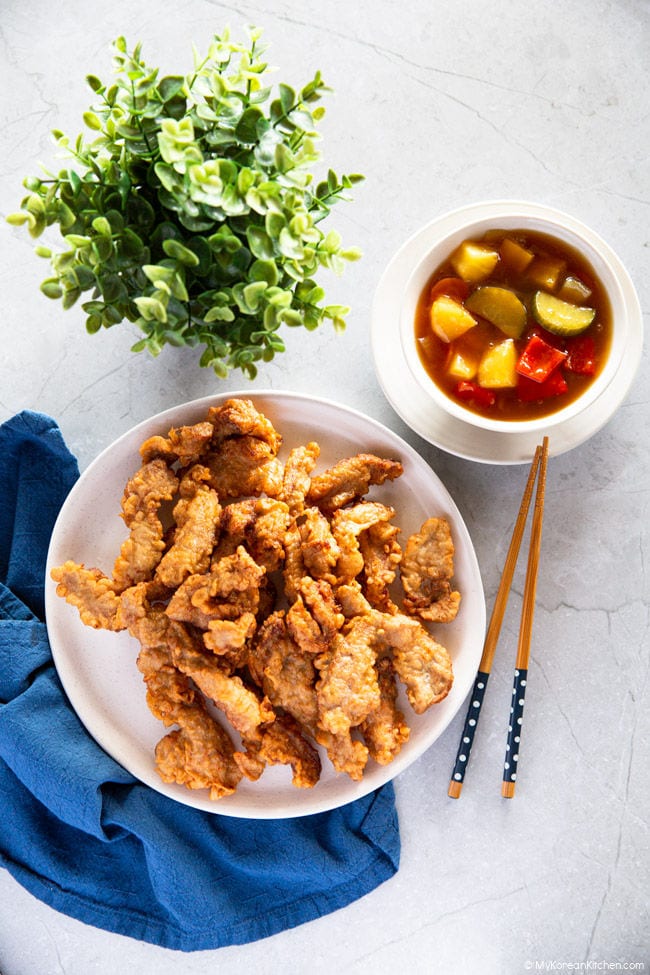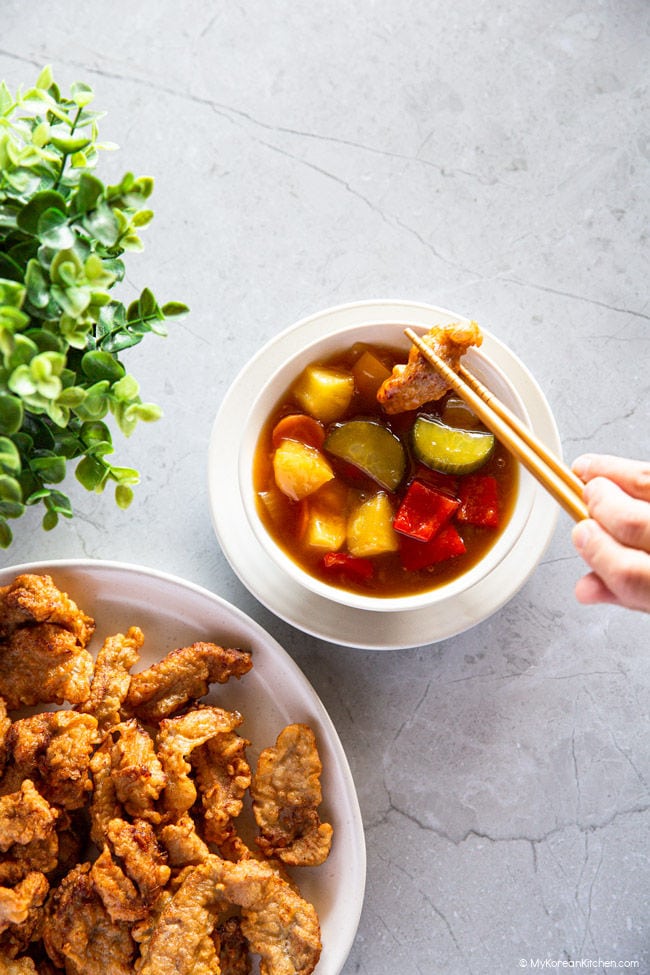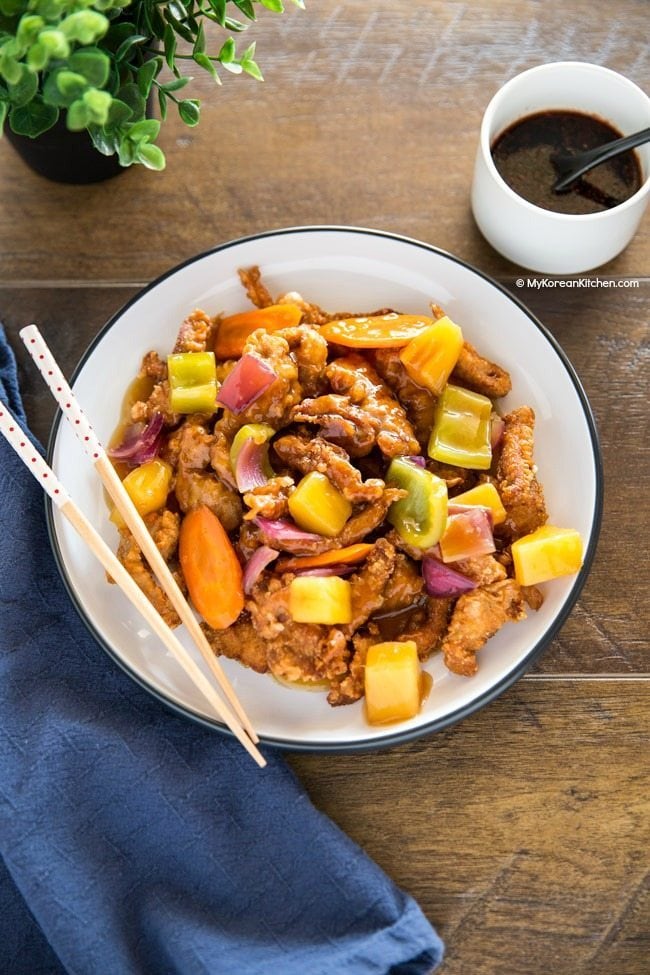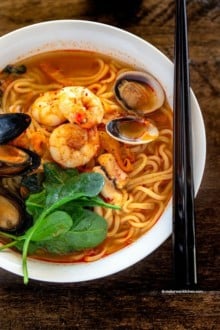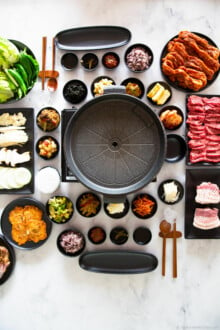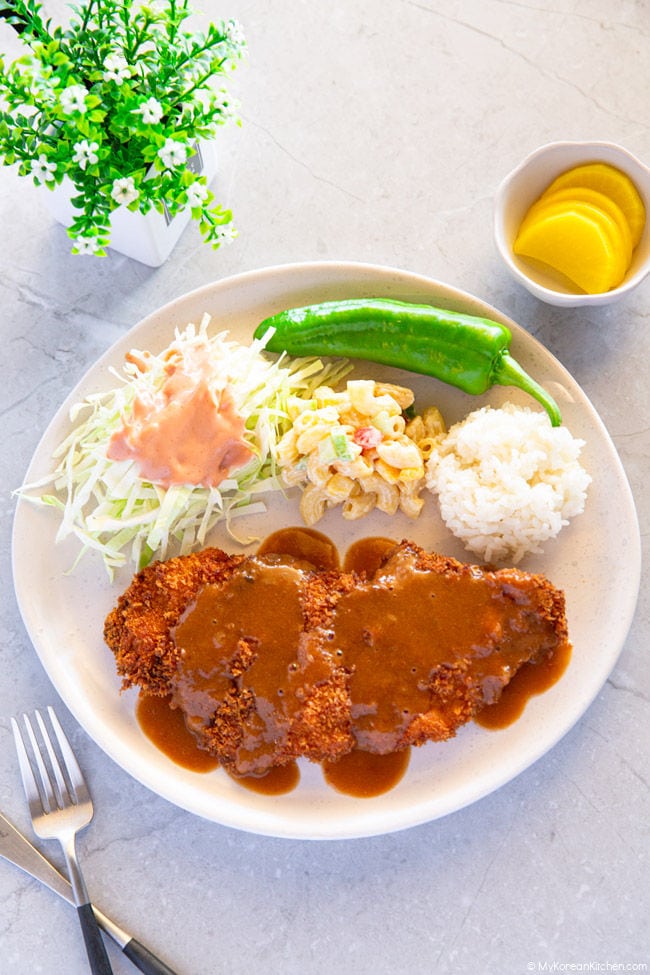Tangsuyuk, also known as Korean sweet and sour pork, is a popular dish among Koreans. The pork is double deep-fried to make it crunchy, and the sauce is a perfect balance of sweet and sour, making it irresistible. I hope you try it soon!

What is Tangsuyuk
Tangsuyuk / Tang soo yook / Tang su yuk (탕수육) is a popular Korean dish presented with deep-fried pork strips and sweet and sour sauce. It is often served as a main dish accompanying Jajangmyeon (black bean noodles) and Jjamppong (spicy seafood noodles) and is most commonly consumed communally.
The meat used in this dish can be pork, beef, or chicken. The chosen meat is seasoned, battered, and deep-fried.
The sauce in tangsuyuk is made from a combination of pineapple juice, soy sauce, vinegar, water and sugar. To give it a crunchy texture, vegetables, such as carrots, cucumbers and bell peppers, are added.
Overall, tangsuyuk is a dish that is crispy and has a delicious sweet and sour sauce.
My Best Tips for Cooking the Perfect Tangsuyuk at Home
1) Batter
In order to make the batter for frying, you’ll need to soak the starch in water. Do not mix or whisk the starch with water, but flatten it gently with a spatula to submerge the starch under water. You don’t need to invest a lot of time for this, just 10 to 20 minutes on the kitchen bench is sufficient. This will allow the water and starch to separate and help create a crispy tangsuyuk coat. Also, it’s important to deep-fry the meat twice to achieve extra crispiness.
2) Sweet and Sour Sauce
Making a delicious tangsuyuk sauce requires a perfect balance of sweet and sour. My recipe produces a well-balanced flavor, but you can always adjust the ingredients to your taste.
Fresh, colorful vegetables are another key ingredient in this sauce. They provide different textures (such as crunch or bite) and add a bright, colorful touch to an eye-catching presentation. I used carrots, onions, cucumbers, and different colored bell peppers, as well as pineapple. You can add other fruits or vegetables for a unique flavor profile, such as apples, kiwi slices, or wood ear mushrooms.
3) How to Serve
When it comes to serving tangsuyuk, there are two ways to enjoy your meat with the sauce. The first way is called “Jjikmeok (찍먹),” where people like to have the sauce on the side and dip the meat in as they eat. Alternatively, you can choose to pour the sauce over the meat, which is called “Bumeok (부먹).”
Jjikmeok has the advantage of keeping the tangsuyuk crispy for longer, as the sauce does not soak through until it is dipped in the sauce. The advantage of Bumeok is that the meat has more time to soak in the sweet and sour sauce, resulting in a saucier dish. Either way, you’re sure to enjoy a delicious meal!
4) How to Store
Tangsuyuk is best served immediately after cooking. However, if you have leftover tangsuyuk, refrigerate it in an airtight container with the sauce separate from the meat. This will preserve the crispness of the meat. If you have an air fryer, reheat in that rather than using the microwave. Refrigerated tangsuyuk should last 3 to 4 days.
5) Make it Ahead of Time
If you’re wanting to make sure your meat is extra crispy for a party or gathering, deep fry it once ahead of time and store it in the fridge. When you’re ready to serve, double fry it. The sweet and sour sauce can be made a day in advance too and just reheated on the stove.
Other Korean Chinese Dishes You Might Like
If you love tangsuyuk, here are some good accompaniments you could enjoy along with it.
- Jajangmyeon (Korean Black Bean Noodles)
- Jjampong (Korean Spicy Seafood Noodle Soup)
- Kkanpunggi (Spicy Garlic Chicken)
Ingredients for Tangsuyuk
Meat
- 500 g / 1.1 pounds pork loin, cut into thin strips (about 1 cm x 5 cm)
Marinade
- 1 Tbsp rice wine (or any cooking wine)
- 1 tsp soy sauce, regular
- 1 tsp fine sea salt
- 1/2 tsp ginger powder (or minced ginger)
- A few sprinkles ground black pepper
Batter
- 1 & 1/4 cup potato starch (or corn starch)
- 1 cup water
- 1/2 Tbsp cooking oil
- 2 egg whites
Fruit and Vegetables
- 150 g / 5.3 ounces pineapple slices, cut into small chunks (I used canned pineapple)
- 1/2 onion (70 g / 2.5 ounces), cut into small chunks
- 1/2 yellow bell pepper (50 g / 1.8 ounces), cut into small chunks
- 1/2 red bell pepper (50 g / 1.8 ounces), cut into small chunks
- 1/4 English cucumber (100 g / 3.5 ounces), cut into small chunks (1cm / 0.4 inch thickness)
- 1/4 carrot (50 g / 1.8 ounce), thinly sliced
Sweet and Sour Sauce (Mix these in a bowl)
- 200 ml water
- 200 ml pineapple juice (I used the juice from the canned pineapple)
- 1/4 cup sugar, raw
- 3 Tbsp soy sauce, regular
- 2 Tbsp apple cider vinegar
Sauce Thickening Agent (Mix these in a bowl)
- 2 Tbsp potato starch (or corn starch)
- 2 Tbsp water
Other
- Some vegetable oil for cooking and deep frying (I used rice bran oil)
* 1 Tbsp = 15 ml, 1 Cup = 250 ml
** For meat, you can use beef or chicken instead. Use lean and tender parts of the meat.
*** Other popular fruit and vegetable ingredient options include wood ear mushrooms and apples.
How to Make Tangsuyuk
1. In order to make the batter for frying, prepare a medium size bowl and add the potato starch and water. Once you have added these ingredients, use a spatula to gently flatten the starch and submerge it under water. It is important that you do not mix or whisk at this time. Instead, leave it on the kitchen bench while you prepare the other ingredients. This will allow the water and starch to separate, which will take approximately 10 to 20 minutes.
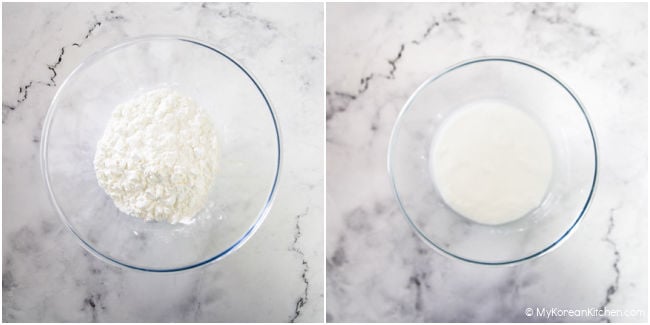
2. Combine the pork with the marinade and mix them well. Set aside (in the fridge) until needed.
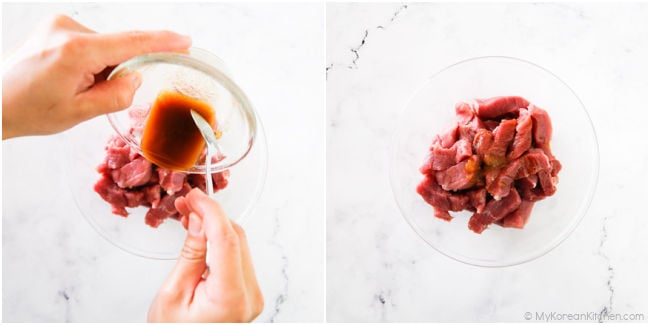
3. Once the starch and water have been separated (from step 1), gently discard the water (the last part of the water includes a bit of starch but it’s okay to discard it). Combine the starch sediment with the cooking oil and egg whites. Mix them well until the texture is smooth (It will be stiff at first, so you might need to use a fork or equivalent tool to mix.). Set it aside.
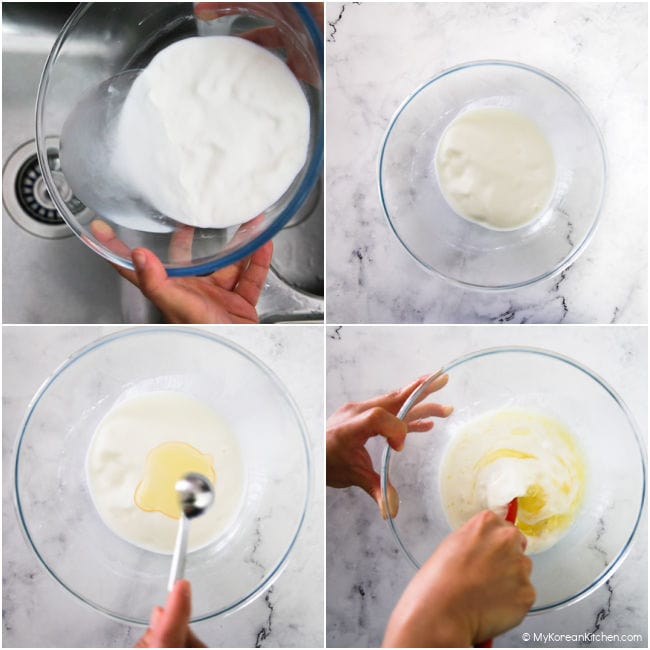
4. Add the pork (from step 2) into the batter bowl (from step 3). Mix them well. Allow the batter to rest for about 10 minutes to allow it to thicken. This will help ensure that your fried pork is very crisp.
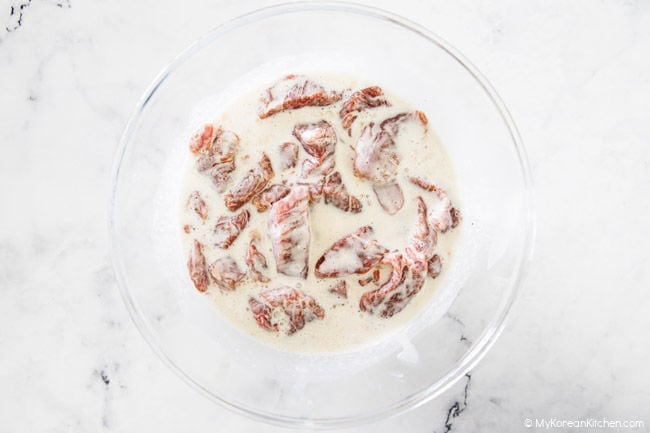
5. Fill a wok with a generous amount of oil and bring it to boil until it reaches 175 C / 350 F (or boiling). (It takes about 5 minutes.) Add the battered pork into the wok one at a time and cook the meat. (It takes about 1 to 2 minutes to cook.) Make sure the wok doesn’t get crowded. Scoop out the meat and move them onto kitchen paper to soak away the excess oil. Repeat this with the remaining meat.
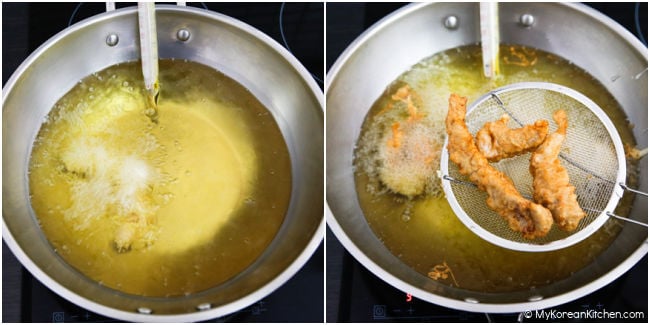
6. In a separate pan, pour the sweet and sour sauce into the pot. Heat the sauce on medium high heat until it bubbles up. Add the carrots into the sauce and boil for 1 minute. Add the remaining fruit and vegetables and boil the sauce a further 2 minutes. Add the thickening agent and stir constantly until the sauce thickens. Remove from the heat.
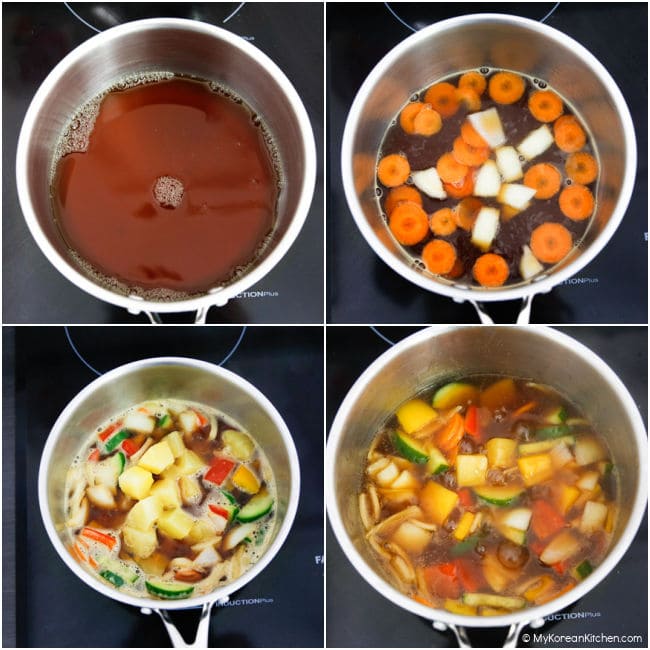
7. Return to the wok. Heat the oil again until it reaches 175 C / 350 F (or boiling). Deep fry all the meat (from step 5) briefly to make it crispier. (The wok can be crowded this time.) Scoop out the meat and place it onto kitchen paper.
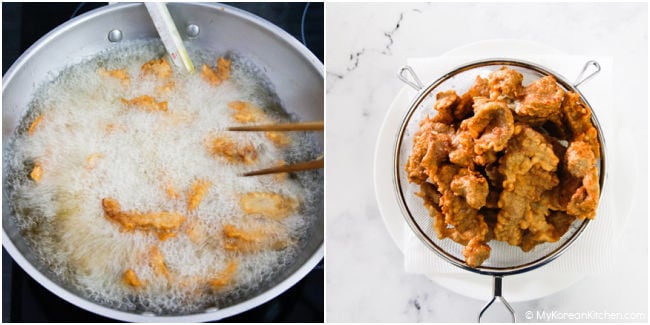
8. Serve the meat on a plate with the sweet and sour sauce over it. Alternatively, you can serve them in a separate plate and a bowl. This will prevent the fried pork from getting soggy. (Some restaurants also serve a Korean dipping sauce for the fried meat. If you want, you can try the meat with it instead of the sweet and sour sauce.)
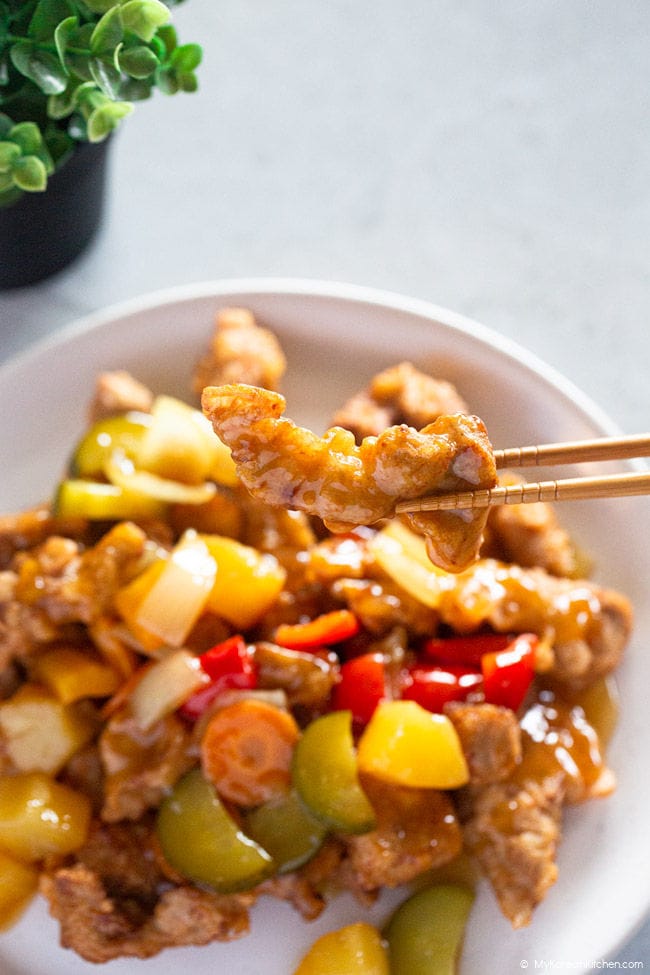
Love Korean food? Browse lots more Korean recipes from my easy Korean recipe collections. And subscribe to my newsletter for all of the latest updates including new recipes, what MKK communities are cooking and K-Dramas!

Tangsuyuk (Korean Sweet and Sour Pork)
Ingredients
MEAT
- 500 g pork loin (1.1 pounds), cut into thin strips (about 1 cm x 5 cm)
MARINADE
BATTER
- 1 1/4 cup potato starch (or corn starch)
- 1 cup water
- 1/2 Tbsp cooking oil
- 2 egg whites
FRUIT AND VEGETABLES
- 150 g pineapple slices (5.3 ounces), cut into small chunks (I used canned pineapple)
- 1/2 onion (70 g / 2.5 ounces), cut into small chunks
- 1/2 yellow capsicum / bell pepper (50 g / 1.8 ounces), cut into small chunks
- 1/2 red capsicum / bell pepper (50 g / 1.8 ounces), cut into small chunks
- 1/4 English cucumber (100 g / 3.5 ounces), cut into small chunks (1cm / 0.4 inch thickness)
- 1/4 carrot (50 g / 1.8 ounce), thinly sliced
SWEET AND SOUR SAUCE (MIX THESE IN A BOWL)
- 200 ml water
- 200 ml pineapple juice (I used the juice from the canned pineapple)
- 1/4 cup sugar , raw
- 3 Tbsp soy sauce , regular
- 2 Tbsp apple cider vinegar
SAUCE THICKENING AGENT (MIX THESE IN A BOWL)
- 2 Tbsp potato starch (or corn starch)
- 2 Tbsp water
OTHER
- Some vegetable oil for cooking and deep frying (I used rice bran oil)
Instructions
- In order to make the batter for frying, prepare a medium size bowl and add the potato starch and water. Once you have added these ingredients, use a spatula to gently flatten the starch and submerge it under water. It is important that you do not mix or whisk at this time. Instead, leave it on the kitchen bench while you prepare the other ingredients. This will allow the water and starch to separate, which will take approximately 10 to 20 minutes.
- Combine the pork with the marinade and mix them well. Set aside (in the fridge) until needed.
- Once the starch and water have been separated (from step 1), gently discard the water (the last part of the water includes a bit of starch but it's okay to discard it). Combine the starch sediment with the cooking oil and egg whites. Mix them well until the texture is smooth (It will be stiff at first, so you might need to use a fork or equivalent tool to mix.). Set it aside.
- Add the pork (from step 2) into the batter bowl (from step 3). Mix them well. Allow the batter to rest for about 10 minutes to allow it to thicken. This will help ensure that your fried pork is very crisp.
- Fill a wok with a generous amount of oil and bring it to boil until it reaches 175 C / 350 F (or boiling). (It takes about 5 minutes.) Add the battered pork into the wok one at a time and cook the meat. (It takes about 1 to 2 minutes to cook.) Make sure the wok doesn't get crowded. Scoop out the meat and move them onto kitchen paper to soak away the excess oil. Repeat this with the remaining meat.
- In a separate pan, pour the sweet and sour sauce into the pot. Heat the sauce on medium high heat until it bubbles up. Add the carrots into the sauce and boil for 1 minute. Add the remaining fruit and vegetables and boil the sauce a further 2 minutes. Add the thickening agent and stir constantly until the sauce thickens. Remove from the heat.
- Return to the wok. Heat the oil again until it reaches 175 C / 350 F (or boiling). Deep fry all the meat (from step 5) briefly to make it crispier. (The wok can be crowded this time.) Scoop out the meat and place it onto kitchen paper.
- Serve the meat on a plate with the sweet and sour sauce over it. Alternatively, you can serve them in a separate plate and a bowl. This will prevent the fried pork from getting soggy. (Some restaurants also serve a Korean dipping sauce for your fried meat. If you want, you can try the meat with it instead of the sweet and sour sauce.)
Notes
- For meat, you can use beef or chicken instead. Use lean and tender parts of the meat.
- Other popular fruit and vegetable ingredients options include wood ear mushrooms and apples.
- 1 Tbsp = 15 ml, 1 Cup = 250 ml
Nutrition Info (per serving)
The nutrition information shown is an estimate provided by an online nutrition calculator. It should not be considered a substitute for a professional nutritionist’s advice.

